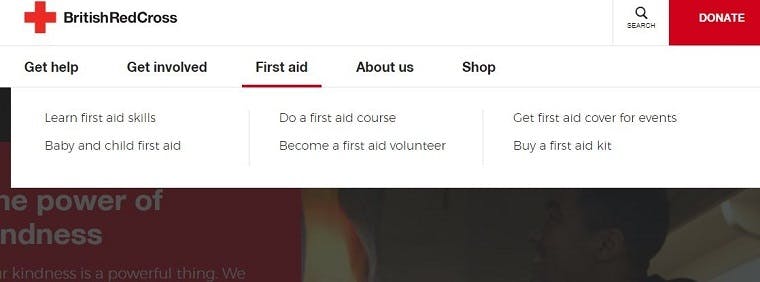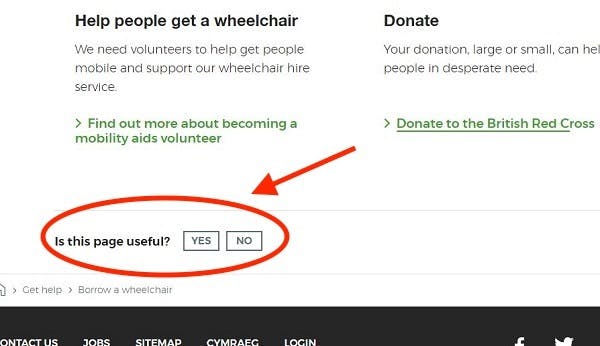As a result of its broad remit, conveying brand purpose (and faciliating consumer understanding) is crucial for the British Red Cross. Its website has recently been refreshed with this in mind, aiming to help users to learn about the different services it offers – from assistance with social isolation to fundraising for victims of global conflict.
I recently spoke with Gemma Hamilton, head of brand and strategic marketing for the British Red Cross, to gain more of an insight into the reasons behind the new site, and the importance of web experience for the charity.
Reasons for the refresh
Gemma began by explaining that it had been seven years since the British Red Cross refreshed its website. This, coupled with research uncovering the fact that people weren’t finding what they needed from the site, led the charity to conclude that the time was right for a revamp (launching the project with creative agency Rufus Leonard).
“We discovered that a large portion of the content on the site wasn’t being used,” Gemma explains. “And at the same time, we took a closer look at who we are as a brand, to really get to the core of what we deliver as an organisation.”
A big part of this is also based on the realisation that people might be unaware of what the British Red Cross actually does. It is a charity perhaps better known for its global fundraising, such as its Syria crisis appeal, but it also provides help for people in the UK who are dealing with issues like social isolation, money problems, as well as the tangible need to hire a wheelchair or commode.
Gemma went on to explain the charity’s two-pronged approach to its website refresh:
We’ve built everything with our brand vision in mind (which is that everyone gets the help they need in a crisis). Essentially, we needed to ensure that we have the best possible platform to enable us to deliver that mission, both in terms of making our web experience simple and accessible enough for people who might want to use our services – such as borrow a wheelchair or access some of our independent living services. But equally, we’re looking to mobilise the support of the great British public and beyond, to contribute to the movement and help people in a crisis in a way that suits them.
In order to do this, the site has been significantly streamlined. “We’ve gone from almost 4,000 pages to just around 400,” Gemma says. “The way that it is designed now is not just talking about our services, it’s actually a service in itself. For example, at the top of the page we have tabs like ‘get help’, ‘get involved’ and ‘shop’, meaning it’s very much geared around what an individual might want to do on the site.”

Indeed, the site now looks and feel much more streamlined, with sections based on whether people are looking to get help or offer it. What’s more, the quality of the content on the site has also been improved. Gemma explains how the charity “looked at the content that was most commonly read and deemed most useful from an audience perspective, and really honed that to ensure it is current, simple, and as valuable as possible.”
Results and what’s to come
Gemma also emphasised that the website is far from finished, with many improvements apparently still to come: “So far the feedback from users has been very positive, but we are constantly monitoring how people are using the new website, and in quite an agile way, using this information to continually refine it”.
Last year, the charity also launched a new donation platform, which has resulted in a 17.5% increase in mobile donations and a 12.4% increase in tablet donations.
Gemma explains the timing was ideal. “It was brought in just before the Manchester bombing appeal, and of course the very high profile ‘One Love Manchester’ concert. It proved it was able to handle an unprecedented level of traffic during that time, which helped us to raise millions.”
So, what other changes are yet to be made?
“We’ve introduced a new feature on the site simply called ‘is this page useful?’ at the bottom of every page,” Gemma says. “It invites users to tell us if what we’ve built for them is useful or not. If not, they can tell us why, and we can use that insight to continually improve.”

This test and learn approach appears to be key across the British Red Cross’ digital strategy.
“Other plans we have for the future are to digitise more of our services, to ensure that they are user friendly and as accessible to as many people as possible, so wheelchair hire, for example. This will enable the website to have even greater utility.”
Meanwhile, Gemma also stresses the importance of a website that aligns with other digital channels. She says it’s not about one channel versus another (i.e. website over social or email), or even that the website is more geared for a particular audience, i.e. fundraisers or beneficiaries. Rather, Gemma says that “It’s about building insight and an understanding of audiences, and having a presence wherever they are. It’s about having a consistent and coherent offering that people recognise across channels, which in turn means they are motivated and able to contribute in a way that suits them.”
Building consumer trust
So, when it comes to donations, what about the issue of consumer trust? Gemma states that this remains a big challenge across the voluntary sector.
“Trust is a hugely important issue,” she says. “It’s critical that we take every step necessary to retain the trust and confidence of the public. We’ve implemented new procedures and robust safeguarding measures to ensure that, for anyone who supports us, they can do so with the confidence that it is in the best interests of the people the charity is supporting.”
I also asked Gemma whether other technology might be on the horizon, such as artificial intelligence for customer service. After all, it appears to have become a bit of a trend for charities in particular, with the likes of Shelter Scotland and Watercap investing in the tech.
Gemma was slightly less sure of the British Red Cross following suit, instead emphasising the charity’s willingness to improve upon what they’ve already got.
“The development of our site was a very involved and significant project for us, and we’re very much looking at what’s next. If there are more innovative ways to improve our services and make them as accessible as we can, we’re absolutely open to that. The key thing for us is to ensure we’re building everything from solid insight and understanding of our audience.”
We are proud of the our volunteers who worked alongside the emergency services and in solidarity with local communities during the 2017 emergencies in London and Manchester. #PowerOfKindness
— British Red Cross (@BritishRedCross) May 18, 2018
A tool for brand purpose
Finally, Gemma finished by speaking about the charity’s tone of voice, and moreover, how this emphasises its brand promise. Alongside social and other marketing channels, the British Red Cross looks upon its website as central to promoting this, using it as an opportunity – not only to provide a service – but to promote what it stands for:
“We are the movement that connects human kindness with human crisis, and our new website is one of the most important and powerful tools for us to be able to fulfil that purpose. To deliver a site that’s now a service in itself is really critical – it’s an expression of who we are and what we want to achieve.”
More on charities:

Comments